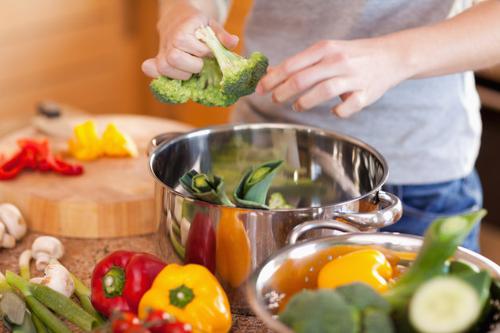Effect Of Heat On Vitamin C
Various cooking methods have different effects on the nutritional content of your food. Cooking – or rather the application of heat – is the most common form of preparation and greatly affects the nutrient content. While vitamins are one of the most common nutrients you can find in foods, heat can have detrimental effects on them. Let's take a look at the effect of heat on vitamins...
Before we get into the effects, you first need to know the common types of vitamins found in food.
1. Types of vitamins in food
Vitamin C and vitamin B complex vitamins are water soluble. The latter is comprised of eight distinct compounds with the most common ones being thiamin, niacin, and folic acid.
The body only uses small amounts of these vitamins at any given time. Any excess is excreted in urine instead of being stored for later use.
Vitamin C is involved in many actions in the body, whereas many of the B vitamins help in the metabolism process.
These kinds of vitamins do not dissolve in the watery parts of the body but seek out fat deposits instead. It is for this reason that they are stored longer in the body.
Fat-soluble vitamins include A, D, E and K. Vitamin K is a key player in the blood clotting process, whereas vitamin A and vitamin E rid your body of dangerous free radicals. Vitamin D is good for your bones.
2. Different cooking methods and their effects on vitamins
Methods of cooking differ depending on what temperature the food needs to read in order to be cooked properly. This means each method affects the vitamins in the food differently.
These three methods for preparing vegetables (foods that contain the most vitamins) involves cooking the vegetables in hot water. The difference between the three methods is the temperature. Boiling occurs at 100ºC/212ºF, whereas poaching occurs at less than 82ºC/180ºF, and simmering ranges from 85ºC to 93ºC/185ºF to 200ºC.
These methods are about how water-soluble vitamins are lost during cooking. In particular, vitamin C, thiamin, and folic acid are the most susceptible to being destroyed in these cooking methods. Half of vitamin C content is lost when you cook veggies in hot water. Around 60 percent of vitamin B is lost when cooking meat because much of the nutrients are contained in the meat juices. You should consider saving the liquid drained from the meat and using it as a base for stew or gravy in order to take full advantage of the vitamins found in the meat juices.
Microwaving is a very common method used for cooking food, especially when you have very little time to prepare something to eat. The food is exposed to heat for only a short time. Because of this, the antioxidant value of vitamins A and E are more or less left intact in foods cooked in a microwave. A significantly smaller amount of vitamin C – only 30 percent – is lost from your vegetables in comparison to the previously discussed water-immersive methods.
Steaming is one of the best ways to prepare vegetables that contain heat-sensitive vitamins. While microwaving greatly reduces the number of vitamins lost, steaming reduces the amount lost even more. In fact, when you steam your vegetables, only around nine to ten percent of the vitamins are lost.

This method involves the use of dry heat to cook food for long periods. Now, with the heat instability of vitamin C, it stands to reason that it will degrade in foods that are cooked by roasting or baking. However, not much is lost in the long run.
So, how does baking affect the nutritional value of food? Well, the most affected vitamin is B complex. This vitamin is found mostly in meat, and it is very sensitive to heat. The vitamin will also be leached away in the juices of the meat during the roasting period, and up to 40 percent can be lost.
Frying is a very popular method of cooking because it makes food taste really good. However, frying temperatures are usually in excess of 150ºC/300ºF, and many of the foods are also peeled in order to fry them. This exposure to immense heat obliterates the vitamins, denaturing their structure. It is best to cut down on how much time the food is fried in order to lose the least amount of vitamins possible.
The different methods of cooking all come with advantages and disadvantages. It is up to you to take into consideration the number of nutrients that will be destroyed in any particular food depending on the cooking time it is going to be subjected to.
Vitamins come in two forms, those that dissolve in water and those that dissolve in fats. The effect of heat on vitamins depends on the type of vitamin and method used for cooking. Water-soluble vitamins are more heat sensitive in comparison to fat-soluble vitamins.
Take care when choosing a cooking method, because different methods utilize various temperatures, resulting in different amounts of vitamins being lost during cooking. However, not all of your nutrients need to go to waste. You can prepare your food by using the tips provided above that ensure nutrients remain in the food.
Source: https://www.tipsandshare.net/what-effect-does-heat-have-on-the-vitamins-in-your-food.html







Tidak ada komentar:
Posting Komentar